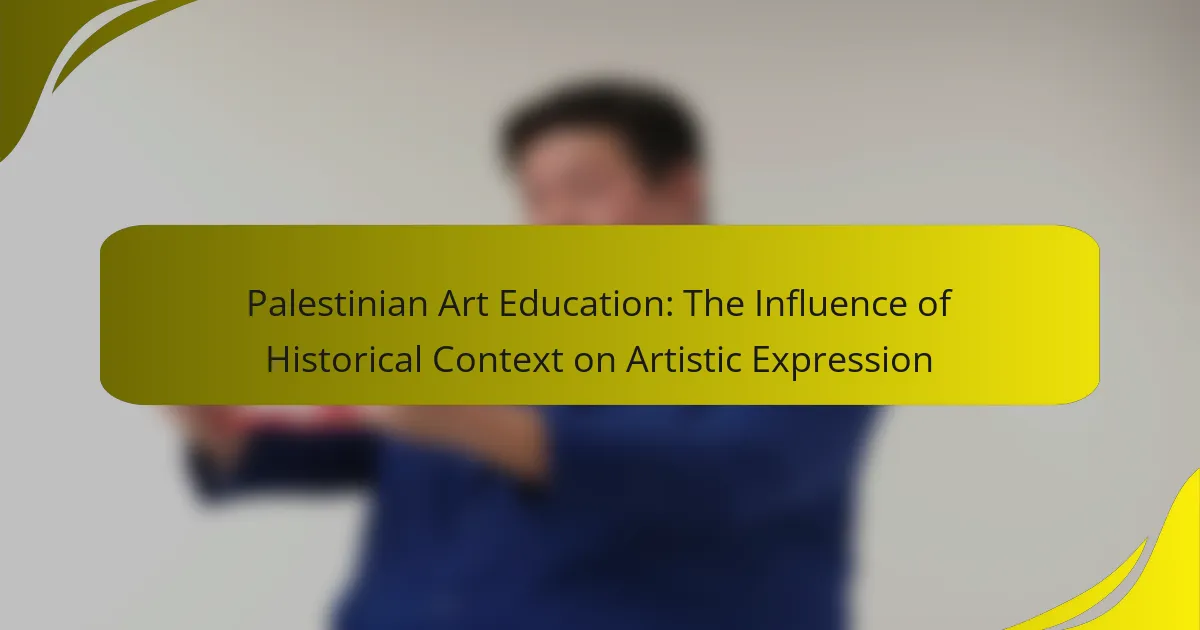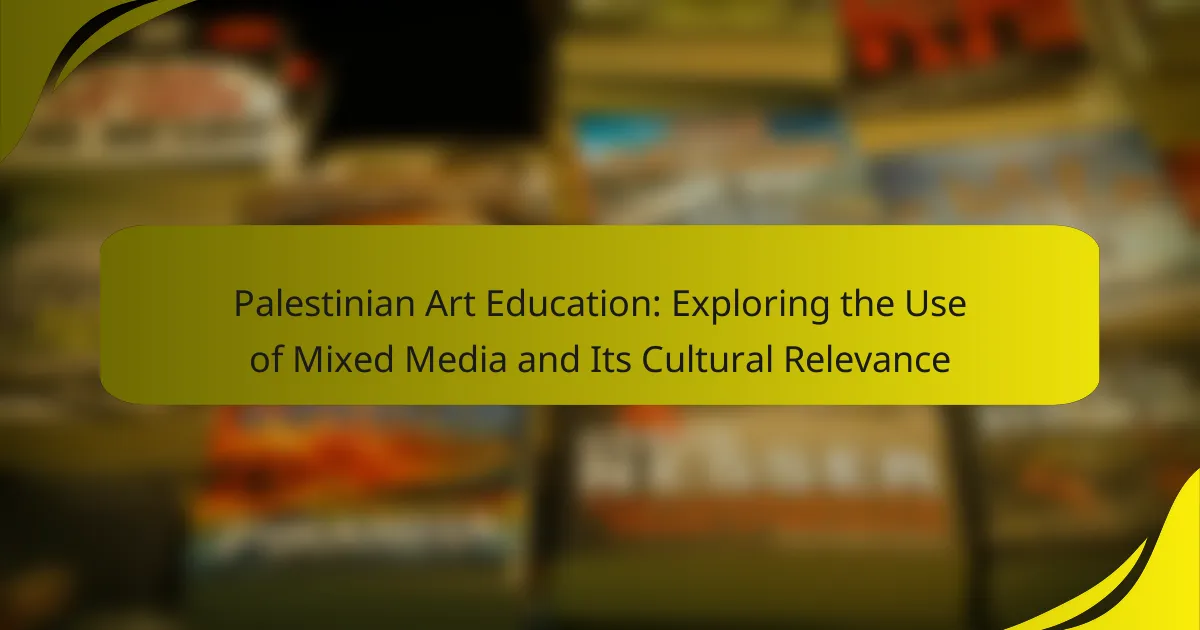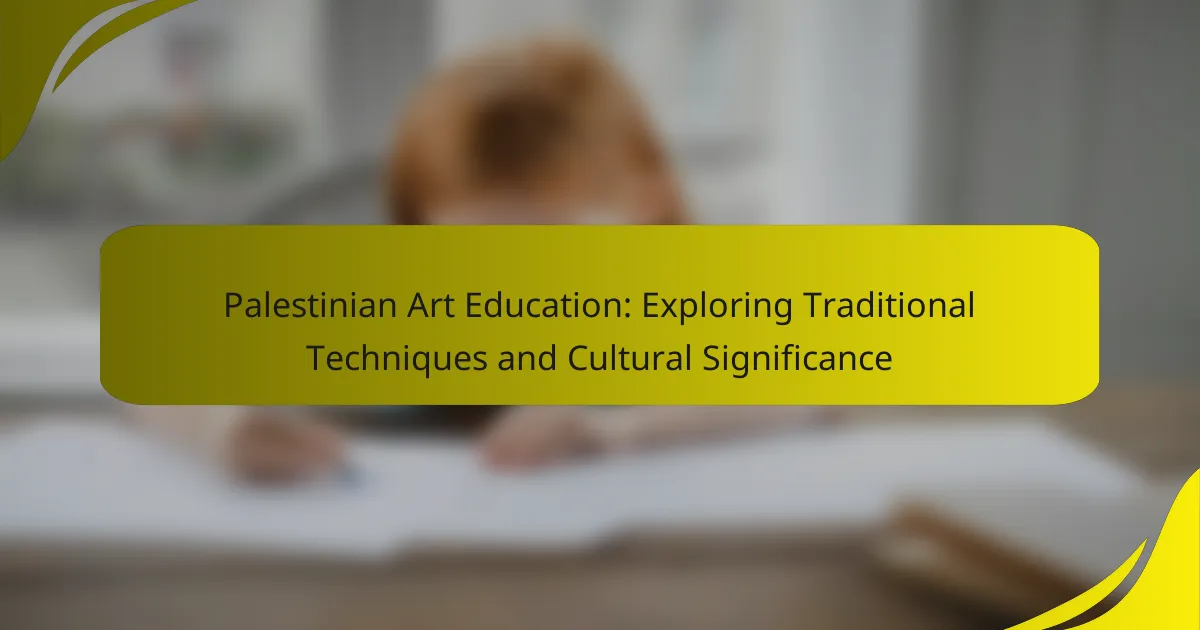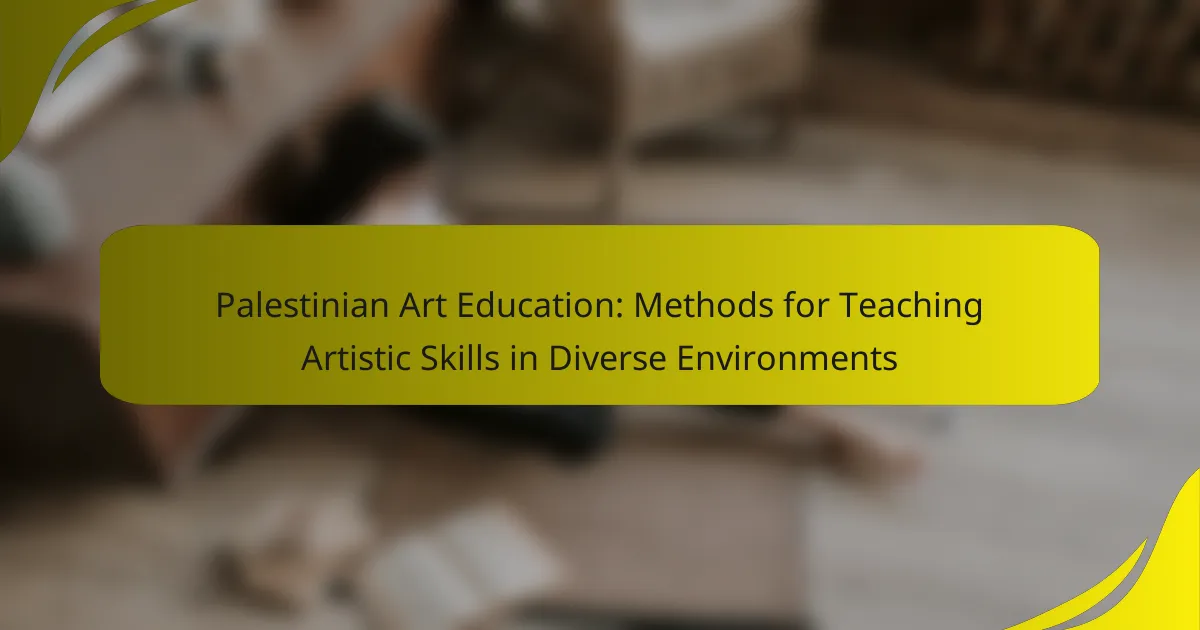Palestinian Art Education encompasses the teaching and learning of artistic practices within Palestinian communities, focusing on cultural identity and social-political narratives. This educational framework fosters creativity and critical thinking while serving as a medium for political expression and resistance, rooted in the historical struggle for identity and self-determination. The article examines visual storytelling methods employed by Palestinian artists, highlighting the integration of cultural narratives and historical contexts through symbolism and traditional motifs. Additionally, it explores the impact of art education on community resilience, self-expression, and social change, emphasizing its role in enhancing critical thinking and stimulating local economies. Overall, the article provides a comprehensive analysis of how Palestinian Art Education shapes cultural identity and empowers marginalized voices.
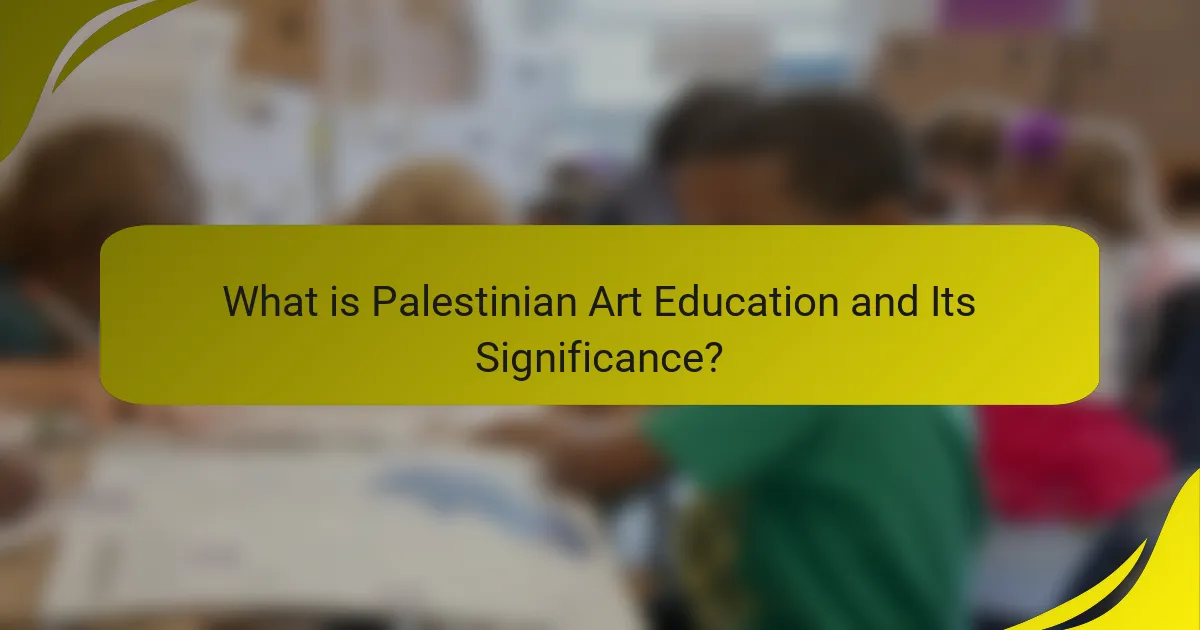
What is Palestinian Art Education and Its Significance?
Palestinian Art Education refers to the teaching and learning of artistic practices within Palestinian communities. It aims to preserve cultural identity and express social and political narratives. This education is significant as it fosters creativity and critical thinking among students. It also serves as a medium for political expression and resistance. Palestinian Art Education has historical roots in the struggle for identity and self-determination. It often incorporates traditional techniques alongside contemporary methods. Research indicates that art education can empower marginalized voices. This empowerment is crucial in the context of ongoing conflict and occupation.
How does Palestinian Art Education foster cultural identity?
Palestinian Art Education fosters cultural identity by promoting the expression of Palestinian heritage through visual storytelling. This educational approach emphasizes traditional themes, symbols, and narratives that resonate with Palestinian history and experiences. Students engage with their cultural roots by creating art that reflects their identity and community. Programs often incorporate local artists and cultural practitioners, providing mentorship and guidance. This connection to local culture strengthens students’ sense of belonging. Research shows that art education enhances cultural awareness and pride among participants. For instance, studies indicate that engaging in cultural art forms can improve self-esteem and community cohesion. By fostering these connections, Palestinian Art Education plays a crucial role in preserving and celebrating cultural identity.
What role does visual storytelling play in Palestinian art?
Visual storytelling plays a crucial role in Palestinian art by conveying cultural identity and historical narratives. It serves as a medium for expressing the struggles and resilience of the Palestinian people. Artists utilize visual elements to depict themes of displacement, loss, and hope. This approach fosters a deeper emotional connection with the audience. For instance, murals and paintings often illustrate significant events in Palestinian history. These artworks not only document experiences but also inspire dialogue about social justice. Furthermore, visual storytelling in Palestinian art enhances community engagement and cultural preservation. It allows artists to share their perspectives while educating others about their heritage.
How does art education contribute to community resilience?
Art education enhances community resilience by fostering creativity and critical thinking. It empowers individuals to express their experiences and challenges through various artistic mediums. Engaging in art education builds social connections among community members. These connections create a support network that can mobilize resources during crises. Additionally, art education promotes cultural identity and pride, which strengthens community bonds. Research indicates that communities with strong cultural ties are more resilient in the face of adversity. For instance, a study by the National Endowment for the Arts shows that arts engagement correlates with increased community cohesion. Thus, art education plays a vital role in equipping communities to navigate and recover from difficulties.
What are the key components of Palestinian Art Education?
The key components of Palestinian Art Education include cultural heritage, visual storytelling, and community engagement. Cultural heritage emphasizes the significance of Palestinian identity and history in artistic expression. Visual storytelling techniques are taught to convey narratives and emotions through art. Community engagement fosters collaboration among artists and educators, promoting shared experiences and collective creativity. These components are essential for nurturing artistic skills and cultural awareness among students. They reflect the unique socio-political context of Palestine, enhancing the relevance of art education in this setting.
Which institutions are involved in providing art education in Palestine?
The institutions involved in providing art education in Palestine include the International Academy of Art Palestine, Birzeit University, and Al-Quds University. The International Academy of Art Palestine offers a Bachelor of Fine Arts program focusing on contemporary art practices. Birzeit University has a Department of Fine Arts that emphasizes both traditional and modern art forms. Al-Quds University provides courses in art and design, fostering creativity and cultural expression. Additionally, local community centers and NGOs, such as the Young Artists Forum, contribute to art education through workshops and exhibitions. These institutions collectively enhance the landscape of art education in Palestine.
What types of art forms are emphasized in the curriculum?
The curriculum emphasizes various art forms, including painting, sculpture, and photography. These forms are integral to expressing cultural narratives and personal experiences. Painting allows for exploration of color and emotion. Sculpture provides a tactile dimension to storytelling. Photography captures moments and conveys messages visually. Each art form contributes uniquely to the overall educational experience. This diversity encourages creativity and critical thinking among students.
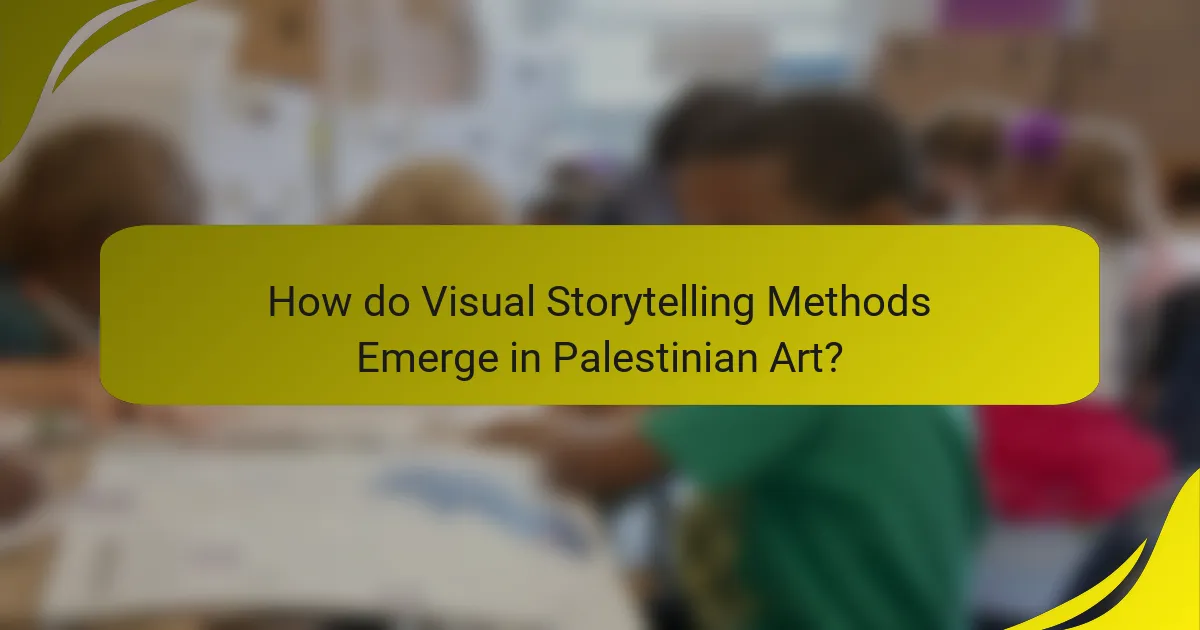
How do Visual Storytelling Methods Emerge in Palestinian Art?
Visual storytelling methods emerge in Palestinian art through the integration of cultural narratives and historical contexts. Artists utilize visual elements to convey collective experiences of displacement and identity. Techniques such as symbolism and color palettes reflect social and political themes. The use of traditional motifs connects contemporary works to Palestinian heritage. Additionally, art education programs emphasize storytelling as a means of cultural expression. Workshops and community projects foster collaboration among artists, enhancing narrative depth. Exhibitions often showcase diverse interpretations of shared experiences. This multifaceted approach enriches the visual language of Palestinian art.
What techniques are commonly used in visual storytelling?
Common techniques used in visual storytelling include imagery, color, composition, and narrative structure. Imagery captures the audience’s attention and conveys emotions. Color sets the mood and influences perception. Composition organizes elements within the frame, guiding the viewer’s focus. Narrative structure provides a storyline that engages the audience. These techniques are essential in creating impactful visual narratives. Studies show that effective visual storytelling can enhance understanding and retention of information.
How do these techniques reflect Palestinian history and culture?
Palestinian art techniques reflect the region’s history and culture through their themes and methods. These techniques often incorporate traditional motifs and symbols significant to Palestinian identity. For example, the use of embroidery patterns in art connects to the cultural heritage of Palestinian women. Additionally, visual storytelling in Palestinian art frequently addresses historical events, such as displacement and resistance. The incorporation of vibrant colors and natural landscapes represents the connection to the land. Techniques like mural painting serve as a form of public expression, showcasing community narratives. The art often engages with political themes, reflecting the ongoing struggle for identity and autonomy. Overall, these techniques serve as a means of preserving and communicating the rich tapestry of Palestinian history and culture.
What impact do these techniques have on audience engagement?
These techniques significantly enhance audience engagement in Palestinian art education. They foster emotional connections through relatable narratives. Visual storytelling captures attention more effectively than traditional methods. Techniques such as symbolism and cultural references resonate with the audience’s experiences. Research shows that engaging visuals can increase retention rates by up to 65%. This heightened engagement leads to deeper understanding and appreciation of the art. Ultimately, these techniques create a more immersive learning environment.
How do artists incorporate personal narratives into their work?
Artists incorporate personal narratives into their work by reflecting their experiences, emotions, and cultural backgrounds. They often use symbolism and visual metaphors to convey their stories. This approach allows them to connect with viewers on a deeper level. For instance, Palestinian artists frequently depict themes of displacement and identity. Their artwork serves as a means of documenting personal and collective histories. Many artists utilize traditional techniques and materials to emphasize cultural significance. This method fosters a sense of belonging and resilience within their communities. Research shows that personal narratives enhance the emotional impact of visual storytelling in art.
What are some examples of artists who use personal storytelling?
Some examples of artists who use personal storytelling include Emily Jacir, Mona Hatoum, and Larissa Sansour. Emily Jacir’s work often reflects her Palestinian heritage and personal experiences. Her installations convey narratives of displacement and identity. Mona Hatoum explores themes of exile and belonging through her multimedia art. Her pieces often incorporate personal and political elements. Larissa Sansour uses film and photography to tell stories about her Palestinian identity. She blends personal history with broader cultural narratives. These artists effectively utilize personal storytelling to address complex social and political issues. Their works contribute significantly to the discourse around Palestinian identity and experience.
How does personal narrative influence the interpretation of art?
Personal narrative significantly influences the interpretation of art by providing context and emotional depth. Individual experiences shape how viewers relate to and understand artwork. Personal stories can evoke empathy and provoke critical thought. For instance, Palestinian artists often embed their cultural and historical narratives into their work. This connection allows audiences to engage with themes of identity, struggle, and resilience. Research indicates that narratives enhance the viewer’s emotional response, making art more impactful. The interplay between personal narrative and art fosters a deeper appreciation and understanding of cultural expressions.
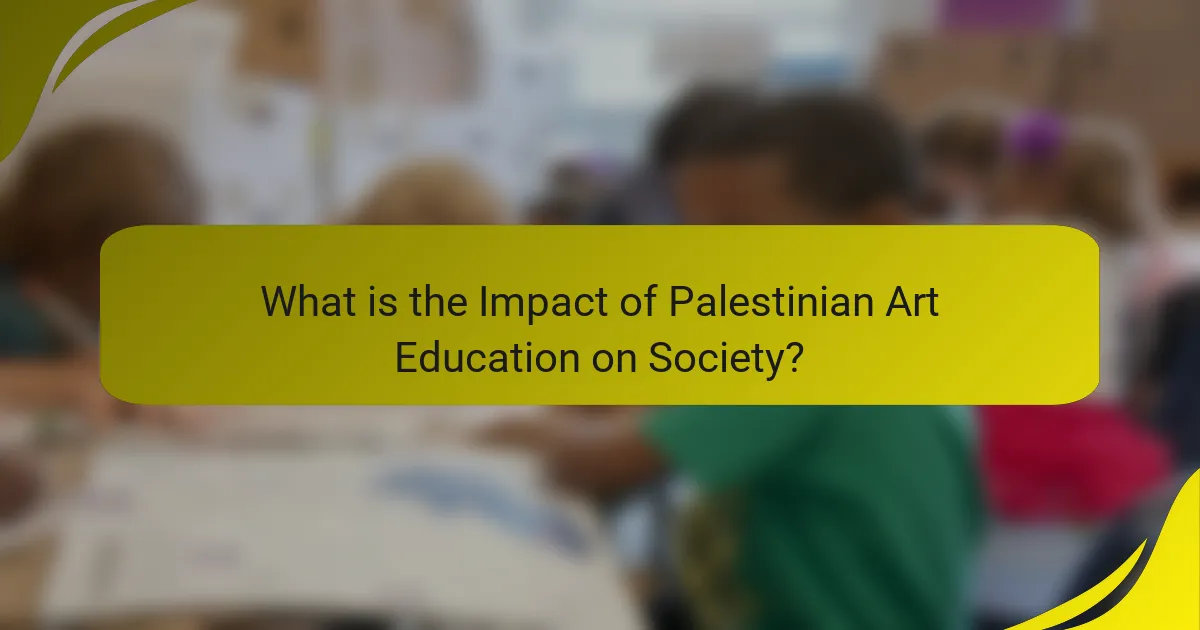
What is the Impact of Palestinian Art Education on Society?
Palestinian art education significantly impacts society by fostering cultural identity and community resilience. It promotes self-expression among youth, allowing them to articulate their experiences and perspectives. Art education serves as a tool for social change, encouraging dialogue about political and social issues. It enhances critical thinking and creativity, skills essential for personal and community development. Programs often address historical narratives, helping students understand their heritage. Research shows that engagement in art reduces feelings of isolation and builds solidarity among individuals. Additionally, art education can stimulate local economies through cultural tourism and creative industries. Overall, it plays a vital role in shaping a cohesive and empowered society.
How does art education empower youth in Palestine?
Art education empowers youth in Palestine by fostering creativity and self-expression. It provides a platform for young people to explore their identities and experiences. Through art, they can communicate their emotions and perspectives on social issues. This form of education encourages critical thinking and problem-solving skills. It also helps in building confidence and a sense of agency among the youth. Programs like the Al-Quds University Art Program have shown positive outcomes in community engagement. Research indicates that art education can enhance cultural awareness and social cohesion. By participating in art, youth in Palestine can contribute to their community’s narrative and resilience.
What skills do students gain through art education programs?
Students gain various skills through art education programs. These skills include creativity, critical thinking, and problem-solving. Art education enhances visual literacy, allowing students to interpret and analyze visual information. It also fosters communication skills, as students learn to express ideas through artistic mediums. Collaboration is another key skill developed, as students often work together on projects. Additionally, art education promotes cultural awareness and appreciation. Research indicates that students involved in art programs demonstrate improved academic performance across subjects. This correlation underscores the multifaceted benefits of art education in fostering essential life skills.
How does art education promote social change and activism?
Art education promotes social change and activism by fostering critical thinking and encouraging self-expression. It empowers individuals to articulate their perspectives on societal issues. Through creative processes, students engage with topics like justice, inequality, and identity. This engagement can mobilize communities around shared causes. Research indicates that art initiatives can lead to increased civic participation. For example, programs in Palestine have used art to highlight social injustices. These programs emphasize storytelling as a means of resistance and awareness. By creating visual narratives, artists can challenge dominant narratives and inspire action.
What challenges does Palestinian Art Education face?
Palestinian Art Education faces numerous challenges. Limited resources hinder access to quality materials and facilities. Political instability affects the curriculum and teaching methods. Restrictions on movement impact students’ ability to participate in workshops and exhibitions. Cultural censorship restricts artistic expression and exploration. Socio-economic factors limit opportunities for professional development. These challenges collectively stifle the growth and recognition of Palestinian artists.
How do political and economic factors affect art education?
Political and economic factors significantly influence art education. Political instability can lead to reduced funding for educational programs. In regions like Palestine, conflict often disrupts access to resources. Economic challenges can limit the availability of materials and facilities for art creation. Additionally, government policies may prioritize certain subjects over the arts. This can result in fewer opportunities for students to engage in creative expression. Historical contexts show that when economies suffer, arts funding is often among the first to be cut. Therefore, the interplay of these factors shapes the landscape of art education.
What solutions are being proposed to overcome these challenges?
Proposed solutions to overcome challenges in Palestinian art education include integrating local cultural narratives into the curriculum. This approach fosters relevance and engagement among students. Additionally, enhancing access to resources such as art supplies and technology is critical. Collaborative projects with international art institutions can provide exposure and new methodologies. Training programs for educators can improve teaching practices and adapt to local contexts. Community involvement in art initiatives can strengthen support networks for students. Implementing online platforms for sharing artwork can broaden audience reach and appreciation. These strategies aim to empower Palestinian artists and educators while preserving cultural identity.
What best practices can enhance Palestinian Art Education?
Integrating community engagement into Palestinian Art Education enhances its effectiveness. Collaborative projects foster cultural exchange and creativity. Incorporating local history and narratives into the curriculum enriches student understanding. Providing access to diverse art forms broadens students’ perspectives. Utilizing technology in art education can enhance creativity and accessibility. Encouraging interdisciplinary approaches connects art with other subjects, fostering holistic learning. Professional development for educators ensures they remain informed about contemporary practices. Establishing partnerships with local artists provides mentorship opportunities for students.
How can community involvement improve art education programs?
Community involvement can significantly enhance art education programs. Engaging local artists and community members provides diverse perspectives. This collaboration fosters a richer learning environment for students. It also encourages cultural exchange and appreciation of local heritage. Community support can lead to increased funding and resources for art programs. Programs that involve the community often see higher student participation rates. Research shows that schools with strong community ties report improved student outcomes. For example, a study by the National Endowment for the Arts highlights the positive impact of community partnerships on student engagement in the arts.
What role does technology play in modernizing art education?
Technology plays a crucial role in modernizing art education by enhancing accessibility and engagement. Digital tools allow students to explore various art forms and techniques online. Virtual reality can immerse learners in art history and interactive experiences. Online platforms facilitate collaboration among artists and educators across geographical boundaries. Additionally, software for graphic design and animation expands creative possibilities. Research indicates that integrating technology in classrooms improves student motivation and learning outcomes. For instance, a study by the National Art Education Association highlights increased student engagement when using digital media in art projects.
Palestinian Art Education focuses on teaching artistic practices within Palestinian communities, emphasizing cultural identity and social narratives. This educational approach fosters creativity and critical thinking, while also serving as a medium for political expression and resistance. The article explores key components such as visual storytelling, community engagement, and the role of local institutions in art education. It also examines the impact of art education on youth empowerment, community resilience, and social change, alongside the challenges faced and proposed solutions for enhancing art education in Palestine.
